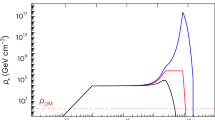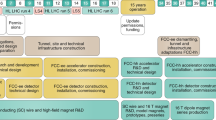Abstract
The best way to study the existence of the Higgs boson, supersymmetry and grand unified theories, and perhaps the physics of dark matter and dark energy, is at the TeV scale. This is the energy scale that will be explored at the Large Hadron Collider. This machine will generate the energy and rate of collisions that might provide evidence of new fundamental physics. It also brings with it the formidable challenge of building detectors that can record a large variety of detailed measurements in the inhospitable environment close to the collisions points of the machine.
This is a preview of subscription content, access via your institution
Access options
Subscribe to this journal
Receive 51 print issues and online access
$199.00 per year
only $3.90 per issue
Buy this article
- Purchase on Springer Link
- Instant access to full article PDF
Prices may be subject to local taxes which are calculated during checkout





Similar content being viewed by others
References
ATLAS Collaboration. ATLAS Detector and Physics Performance: Technical Design Report. Report No. CERN/LHCC/99-15 (CERN, Geneva, 1999).
ATLAS Collaboration. ATLAS: Technical Proposal for a General-Purpose p p Experiment at the Large Hadron Collider at CERN. Report No. CERN/LHCC/94–43 (CERN, Geneva, 1994).
CMS Collaboration. CMS Physics Technical Design Report Vol. I. Report No. CERN/LHCC/2006-01 (CERN, Geneva, 2006).
CMS Collaboration. CMS Technical Proposal. Report No. CERN/LHCC/94–38 (CERN, Geneva, 1994).
Ellis, N. & Virdee, T. S. Experimental challenges in high luminosity collider physics. Annu. Rev. Nucl. Part. Sci. 44, 609–653 (1994).
Froidevaux, D. & Sphicas, P. General purpose detectors for the Large Hadron Collider. Annu. Rev. Nucl. Part. Sci. 56, 375–440 (2006).
Gianotti, F. European School of High-Energy Physics, CERN Yellow Report. Report No. CERN-2000-007 219–244 (CERN, Geneva, 1999).
LHCb Collaboration. LHCb Technical Proposal. Report No. CERN/LHCC/98–104 (CERN, Geneva, 1998).
Yao, W.-M. et al. Review of particle physics. J. Phys. G 33, 1 (2006).
Doležal, Z. et al. The silicon microstrip sensors of the ATLAS semiconductor tracker. Nucl. Instrum. Methods 578, 98–118 (2007).
CMS Collaboration. Addendum to the CMS Tracker TDR. Report No. CERN/LHCC 2000-016 (CERN, Geneva, 2000).
LHCb Collaboration. LHCb TDR 5 Report No. CERN/LHCC 2001-011 (CERN, Geneva, 2001).
LHCb Collaboration. Second Addendum to the Muon System Technical Design Report. Report No. CERN/LHCC/2005-0012 (CERN, Geneva, 2005).
Foster, I. & Kesselman, C. The Grid: Blueprint for a New Computing Infrastructure (Morgan & Kaufmann, San Francisco, 1998).
LCG project. LHC Computing Grid Technical Design Report. Report No. CERN/LHCC/2005-024 (CERN, Geneva, 2005).
Acknowledgements
This review article is largely based on the very complete documentation already existing for the ATLAS, CMS and LHCb experiments, and on refs 1–8 in particular. Furthermore, with around 5,000 scientists involved in the construction of the experiments described, I can only cover a small part of the challenges, excitement and difficulties involved in making them a reality. The best I can do is therefore to acknowledge all of the members of these collaborations, and in particular those who have helped me with corrections and comments, and apologize for all the dedicated sub-projects and work I had to leave out of this review.
Author information
Authors and Affiliations
Ethics declarations
Competing interests
The author declares no competing financial interests.
Additional information
Reprints and permissions information is available at npg.nature.com/reprintsandpermissions.
Correspondence should be addressed to the author (steinar.stapnes@cern.ch).
Rights and permissions
About this article
Cite this article
Stapnes, S. Detector challenges at the LHC. Nature 448, 290–296 (2007). https://doi.org/10.1038/nature06078
Published:
Issue Date:
DOI: https://doi.org/10.1038/nature06078
This article is cited by
Comments
By submitting a comment you agree to abide by our Terms and Community Guidelines. If you find something abusive or that does not comply with our terms or guidelines please flag it as inappropriate.



